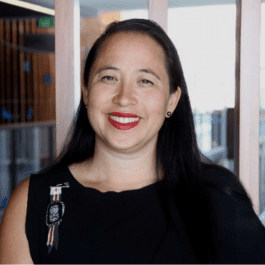IP-AI •
Modelling AI off the Human Brain

Dr Melanie Cheung (Ngāti Rangitihi, Te Arawa) is committed to exploring both Indigenous and Western scientific paradigms to help people with neurodegenerative diseases. Dr. Cheung attended the March 2019 Indigenous Protocol and Artificial Intelligence workshops in Hawai’i. Here she explores how AI might impact Indigenous communities.
Until now, artificial intelligence isn’t something I have thought very deeply about. I was never into science fiction. I never studied information technology. The fact that I now work in tech, despite being slightly technophobic, is kind of funny. I am a Māori neuroscientist that has spent the best part of two decades studying the human brain. It’s really an exquisite organ that allows us to see, hear, touch, taste, smell, think, feel, act, create, joke and move. The brain is sacred to Māori and interaction with it is restricted. A component of my research has involved working with kaumatua (elders) to decolonize our laboratory and clinical practices through developing tikanga (customary practices) that acknowledge sacredness, spirit, culture and community within neuroscience.
“The brain is sacred to Māori and interaction with it is restricted. A component of my research has involved working with kaumatua (elders) to decolonize our laboratory and clinical practices through developing tikanga (customary practices) that acknowledge sacredness, spirit, culture and community within neuroscience.”
My area of expertise is neuroplasticity, the brain’s extraordinary ability to change its structure, function and connections in response to the input it receives. Through providing specific inputs that therapeutically alter the structure, function and connections in dysfunctional neural networks, we’ve been able to develop neuroplasticity-based treatments for a wide range of brain disorders. The inputs that drive these changes involve online brain training, which is why I now work in tech.
So, when I think about what the future looks like for artificial intelligence, I think about the increasing ability for computers to be able to model the human brain. We know that computers can learn, so there is some degree of neuroplasticity. But computers will always be limited because the learning needs to be programmed by humans. Although, you could argue that the human brain is programmed by experience.
One of the reasons the human brain is able to change so readily is because it is a biological system that contains all the cellular machinery and elements that are required for connections to be formed, reinforced and broken: DNA, RNA, proteins, neurotrophic factors, neurotransmitters, receptors, cell membranes, energy sources, transport networks, etc. While synthetic biology is able to engineer artificial eukaryote cells that mimic biological cells, these are nowhere near as sophisticated as a brain cell. Artificial cells that conduct electricity akin to brain cells have also been created, but they can’t carry out other complex cellular functions of brain cells. It’s only a matter of time before synthetic biology and machine learning scientists combine their knowledge to develop a synthetic biology-based brain-like computer. But to what end?
Why are we interested in creating machines that have human-like intelligence?
What will the real cost of artificial intelligence be on our Indigenous communities?
Will people lose their jobs because machines will be built to be more efficient than humans? Could the vast amounts of money poured into artificial intelligence research be better used on improving Indigenous health and living conditions or protecting our environment?
How can we develop artificial intelligence technology that improves quality of life for Indigenous peoples rather than creating yet more disparity?
How can Indigenous peoples be involved in decision making about artificial intelligence? What do our elders have to say about artificial intelligence?
What decolonizing methodologies can we develop to determine how we want to interact with artificial intelligence?
Author Bio:
Dr. Melanie Cheung (Ngāti Rangitihi, Te Arawa) is committed to exploring both Indigenous and Western scientific paradigms to help people with neurodegenerative diseases. Consequently, her work integrates experimental neurobiology, bioethics, tikanga (ceremony/customary) and Mātauranga Māori (Maori traditional knowledge).
Since 2007 Melanie and her research team have worked closely with a large Taranaki Māori family that have Huntington’s disease, a dominantly inherited neurodegenerative disease that affects movement, personality, and higher cognitive functions. Dr Cheung’s previous research projects have included: Āta Photovoice Research Project highlighting the Taranaki families’ wellbeing practices; Te Mata Ira, a bioethics project investigating Māori views on biobanking and genomic research; Validating a transgenic songbird model of Huntington’s disease (with Rockefeller University, New York); The isolation and culturing of 19 novel primary human cell culture models of brain disease; Using Indigenous values and practices in scientific practice, with specific focus on developing culturally respectful laboratory practices for working with human tissue. This research was featured in Science (2007, 318:907) and ABC’s award winning All in the mind radio show (3 May, 2008).
Melanie has worked throughout USA, Hawaii and Australia. She undertook research as a visiting scholar at: Brain Plasticity Institute, Posit Science in San Francisco; Nottebohm Laboratory, Rockefeller University in New York and the Indigenous Wellness Research Institute, University of Washington in Seattle. She has also been a visiting lecturer at School of Education, University of Hawai’i in Hilo and School of Indigenous Australian Studies, James Cook University in Cairns, Australia.
The Indigenous Protocols and Artificial Intelligence (IP-AI) workshops are founded by Old Ways, New, and the Initiative for Indigenous Futures. This work is funded by the Canadian Institute for Advanced Research (CIFAR), Old Ways, New, the Social Sciences and Humanities Research Council (SSHRC) and the Concordia University Research Chair in Computational Media and the Indigenous Future Imaginary.